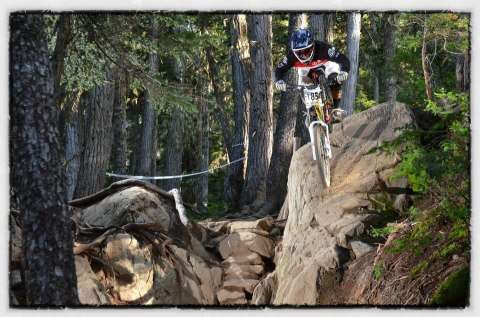There is a lot of dangerous misinformation on the subject of braking on your mountain bike, I will clear some of it up for you. YOUR BUTT is Not Your Third Brake! We were horrified when one of our downhill camp students told us that in the high school league the coaches were teaching students to get their butt way back while braking and using the phrase, “your butt is your third brake”. After explaining to him why this was bad he said, “Wow, that is why my coach broke his corner bone! We were riding down a steep hill with a few ledges and he was braking over one of the ledges and got catapulted over the bars because he was yanked forward.”
As the sport of mountain biking has matured there have been huge changes in both equipment and the understanding of proper riding technique. When I started BetterRide in 1999 there were few people coaching technique and most advice was given by great racers who had created their own techniques. Often, these great racers were not the best bike handlers (simply really fit) and even if they were they weren’t great at explaining how and why a certain technique should be used.
So my task was to find out what worked, why it worked and how to get you to do that technique. Fortunately, I had been doing that for 10 years as a snowboard coach and since my passion for snowboarding had faded I put all of my coaching energy into mountain biking. I sought out the best motorcycle coaches (Danny Walker, Gary Semics and Keith Code) to learn from and have worked with and coached some of the best racers in the world (Greg Minnaar, Marla Streb, Ross Schnell, Lynda Wallenfels, Mitch Ropelato, Chris Van Dine, Cody Kelly, Erica Tingey, Kelli Emmett, Jackie Harmony, Sue Haywood, etc.) As you can imagine I learned a lot over those years and I have often had to rethink the skill I was teaching and rethink my methods for getting you to master that skill. Which is a polite way of saying that some of what I taught was wrong!
One of the skills I was teaching incorrectly was braking. I had a student wash out his front tire and crash doing a braking drill one day in 2004. Although he was doing the drill slightly wrong (he shifted his weight back before he braked, not as he braked) it made me question the idea of getting your butt way back while braking. It turns out that it didn’t jive with my in balance and in control philosophy (the student was obviously neither in control nor in balance when he crashed). I also noticed great racers like Steve Peat and Greg Minnaar were staying centered while braking. So in 2004 I threw out the little drawing that I had been using since 1999 to explain this (A rider with an arrow driving from his butt through his bottom bracket into the ground showing the “physics” of getting your weight back while braking). It was pretty handy and powerful in explaining the “physics” of why we get our weight back while braking! The problem was it doesn’t work that way in real life, on a trail with changing traction conditions, bumps, rocks and small ledges. You need to get low and stay centered while braking!
Forgetting about dangerous misinformation, it is plain instinctual to move away from danger, in this case moving your butt back as you brake. Unfortunately, as you probably know our instincts are terrible mountain bike skills teachers as they are thousands if not millions of years old! They became instincts to help us survive as bipeds in those times (before bikes, motorcycles, and cars). For more info on this read this article: Why Our Instincts Fail Us On Our Mountain Bikes! https://dev.betterride.net/blog/2011/why-our-instinicts/
The first reason we don’t scoot our butt back when braking is the same reason we don’t do it descending (which by the way, most braking is done descending!). It will put us in a non-neutral position and cause us to get out of balance, greatly increasing our chance of flipping over or just crashing. As explained and demonstrated in this video:
The second and third reasons we don’t want to use our butt as the third brake are it will minimize the power of the front brake and put us out of position to do whatever we are braking for (a corner, a rock garden, a loose section, etc.). Which leads us to this interesting braking and cornering question asked by one of our students:
“Just a quick follow-up question. I have been having a problem getting out of position before cornering, primarily caused by hard braking (especially if there are rough terrain before the corner or if I come in too hot). As I brake, my body gets behind the center and lower as well, and by the time I start entering the corner, I am out of the “attack” position. My front wheel feels light, and it becomes difficult to get in the correct cornering body position.
If you have suggestions as to how to properly transition from braking into cornering (especially under hard braking), I would appreciate it.”
Interesting question, I have been working on the same issue, especially last year at Snowmass. The problem stems from getting back while we brake, getting low is good but we need to stay more centered so when we release the brakes and the bike accelerates we are centered and ready to attack the corner. I was taught the old school, “get way back while you brake” which does help the rear brake a bit but actually hurts the effectiveness of the much more powerful front brake (why maximize 10-25% of your braking power while minimizing 75-90% of it?). Getting back also puts me out of balance and makes it hard to corner correctly. My entire focus at the last two races has been to stay centered as I brake, use A LOT of front brake and then let off and attack the corner. Believe me, the entrances to these corners are really rough and brake bumped, but you can still stay centered. When working with Greg Minnaar he really stresses this. It sounds scary but once you do it you realize two things: 1. you can brake in a much shorter distance with more control (more front wheel traction and less front wheel slide) 2. you are in a much better position to corner when you let off the brakes. Also, remember to only brake to slow down in a straight line (before the corner). This is another reason to practice the braking drills from the camp you took. On a side note one of our fastest students, Cody Kelly told me that he is now wearing out two sets of front brake pads before one set of rear pads! That shows correct braking and is one of the reasons Cody is so fast (he won the Sea Otter Dual Slalom!).
Watch the World Cup downhill races on Redbull.com, you will not see Aaron Gwin, Greg Minnaar, Mitch Ropelato, Steve Peat or pretty much any of the racers getting back as they brake for a corner or challenging section of trail!
As always it comes down to doing the drills we taught you to master the skills, then practicing with purpose and a focus on quality!
A great braking and body position drill you can do to feel what is right and what is wrong with braking body position is the front brake drill. First a warning, if you are not confident descending and using your front brake do not do this (start with the braking drill in our mini-course)! If you are confident, find the steepest semi-loose dirt/hard packed sand hill you are comfortable going down and descend it the way you always have to make sure you are honestly comfortable. Once you have decided you are comfortable approach the hill slowly and gently, slowly apply just your front brake (letting off a bit and adding some rear brake if you get scared/feel out of control) and descend the hill low and centered (drop your seat, hinge at your hips to lower your chest and as your chest lowers your butt will scoot back a hair but you will be able to maintain a “half-push up bend” in your elbows). After descending it once front brake only do it a second time but this time focus on speeding up just a bit and slowing back down (again using just the front brake). Now you should have a great idea of what it feels like to be low, centered and neutral. Now do the descent a third time, this time slowly scoot your book back with the goal of getting your butt way back like a third brake. Well before you get your butt way back you will feel the front wheel start to slide as you start taking weight off it, this should be scary and to correct it move forward towards the centered position. You have now learned that by getting back you greatly compromise how much front brake power you can use, which is scary as on a steep hill your front brake is 90-100% of your braking power. Now, if you still are not convinced, try to do the same descent rear brake only! If it is as steep as the hills we use in our camps to demonstrate this you will not be able to descend in control using just the rear brake (no matter how far back your butt is).
Focus on being centered, neutral and in balance when descending! Create a railed corner (or two)!





So are all those Mountain Bike Action cover photos of riders with their arms extended and saddles under their navels demonstrating bad form?
Yes Dan, they are. You never want to ride like that. It is OK for an instant, such as when manualing to decrease the angle of incident when transitioning from a steep hill to flat ground.